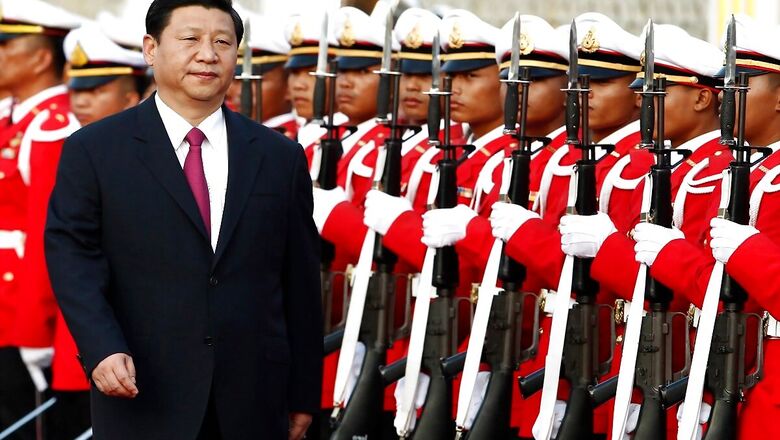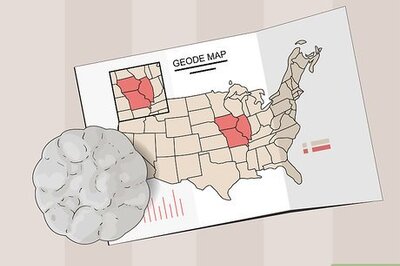
views
The short-notice Colombo visit of a high-level Chinese delegation, to be followed now by US Secretary of State Mike Pompeo’s this month-end should be of interest as much to the Indian strategic community as to their counterparts in Sri Lanka. The question is that if the Chinese visit was a reaction to the recent Quad Ministerial at Tokyo, and the delayed one by Secretary Pompeo, likewise, has been influenced by the latter.
“Negotiations are underway for a ¥10 billion (Renminbi) currency-swap agreement between the Central Bank and the People’s Bank of China, to address the current liquidity crunch,” Colombo-based Daily Mirror quoted Ajith Nivard Cabraal, Sri Lanka’s Money, Capital Markets and Public Enterprise Reforms Minister, only days after the visit of a Chinese delegation, headed by former Foreign Minister, Yang Jiechi, now a leading Politburo member. Converting as $1.5 billion swap (appx), this is much bigger than the $400 million swap deal with India, with ‘technical negotiations’ already on for another $1 billion swap.
The question is that if the Chinese visit was a reaction to the recent Quad Ministerial at Tokyo, and the delayed one by Secretary Pompeo, likewise, has been influenced by the latter.
Central Bank Governor during the presidency (2005-15) of Mahinda Rajapaksa, now Prime Minister, Cabaral recalled how he had signed such a deal in his time. As if to make greater sense, or make light of what is otherwise seen as a further Sri Lankan tilt towards China, he indicated the possibility of the Government approaching the IMF for funding, instead. “If we have to go and hold the International Monetary Fund’s (IMF’s) hand — or if the IMF has to hold our hand — that, I think, is a danger signal. We know we have to get our debt situation under control. Do we need the IMF to say that? No,” he said, by way of explanation.
Gota Visiting Beijing
During the Yang team’s visit, China offered a $90 million grant towards Covid-related medical assistance, promised a further $500 million loan to Sri Lanka, repayable in ten years. The loan-agreement, as it turns out, was to have been concluded during Prime Minister Mahinda Rajapaksa’s Beijing visit, which had to be delayed, and will be signed soon in the Chinese capital.
Following the successful conclusion of exchanges between the two sides, Sri Lankan President Gotabaya Rajapaksa is expected to visit China, later this year — his first after assuming office. Thus far, also because of the intervening Covid-19 pandemic, President Gotabaya’s overseas visit was restricted to meeting with neighbouring India’s Prime Minister Narendra Modi, in New Delhi.
At talks with the Chinese delegation, President Gotabaya pointed out that China had been a long-standing friend to Sri Lanka, It supported Sri Lanka to defeat terrorism and to build infrastructure, including the Hambantota Port, the Port City and Southern Expressway. He highlighted how “irrespective of the administration in power” in Colombo, bilateral ties had grown.
Thus far, also because of the intervening Covid-19 pandemic, President Gotabaya’s overseas visit was restricted to meeting with neighbouring India’s Prime Minister Narendra Modi, in New Delhi.
As if in this context, President Gotabaya said that the Hambantota Port was Sri Lanka’s idea, and not that of China, and the latter offered to fund it. Now, many geopolitical analysts call it a Chinese debt-trap to gain control over Sri Lankan affairs. “I want to prove that it is not the case and that this large-scale project will help improve the living standards of the people.” He did not explain how, considering that this or no other China-funded project provided jobs for the locals. If the current focus is on the promised Chinese-funded SEZ at Hambantota, it remains to be seen, how much of Sri Lankan exports (as against imports) would it handle.
Read between the lines, Gotabaya was sending out a message to overseas critics that Hambantota was a ‘national project’ of Sri Lanka and there was across-the-board consensus in the matter. Clearly, he was referring to the predecessor Government of Prime Minister Ranil Wickremesinghe converting Mahinda era construction-cum-concession contract into a ‘debt-equity swap’ deal, handing over Sri Lankan ‘territory’ to a Chinese firm on a 99-year lease.
According to official release from the Sri Lankan President’s office, Gotabaya said he wanted to bring to Sri Lanka the type of development in rural areas that he had seen during his 13 visits to China before he became President (mostly when he was war-time Defence Secretary under President Mahinda, his brother).
Read between the lines, Gotabaya was sending out a message to overseas critics that Hambantota was a ‘national project’ of Sri Lanka and there was across-the-board consensus in the matter.
Gotabaya wanted Sri Lanka’s trade-deficit with China to be lowered with China buying more Sri Lankan goods. He pressed for more Chinese investment and visitors. He encouraged Chinese participation in the domestic tea-auction. He also called for the establishment of a technology university in Sri Lanka with Chinese backing. According to reports, the two sides will also revive negotiations on bilateral FTA, stalled during the Wickremesinghe rule.
Independence and Sovereignty
Yang declared that China will firmly stand with Sri Lanka to protect the country’s independence, sovereignty and territorial integrity at international fora, including the UNHRC (where Colombo faces reprimand of some kind in the March 2021 session, after a two-year leeway, incidentally enjoyed by the Wickremesinghe regime).
In a recent interview to the Daily Mirror, Alaina B. Teplitz, the US Ambassador to Sri Lanka, in a to a Colombo-based newspaper. “Sri Lanka should engage with China in ways that protect its sovereignty. Sri Lanka is a sovereign nation, but we do believe it is better for countries if transactions are transparent and cost-effective, and if they create jobs and other material benefits for local people.”
It is in this context, revived talks of an early Colombo visit by US Secretary of State Mike Pompeo, towards October-end, assumes added significance. While the visitor will press the hosts on the pending US proposal on the $480 milliom ‘Millennium Challenge Cooperation’ (MCC) connectivity project in Sri Lanka, the Rajapaksa leadership can be expected to feel the pre-poll American pulse on the UNHRC resolution.
Yang declared that China will firmly stand with Sri Lanka to protect the country’s independence, sovereignty and territorial integrity at international fora, including the UNHRC.
The US concerns on China in Sri Lanka’s Indian Ocean trijunction with India and Maldives are well known. The US and India are partners in the four-nation Quad, also involving Japan and Australia. Recently, it signed a ‘Framework Agreement’ for military cooperation with Maldives. Back home after the Quad Ministerial in the Japanese capital recently, Secretary Pompeo declared that “India needs the US as ally” and talked about the ‘China risks.’
According to media reports, Secretary Pompeo’s Colombo visit is timed to coincide with his presence in Delhi. Citing Pompeo dropping his planned Colombo visit last year after Gotabaya became President, a section of the Sri Lankan strategic community is curious if the rushed visit now was prompted by the Chinese delegation.
Form and Content
The Chinese visit happened days after Prime Minister Mahinda had held the customary first consultations after coming to power with Indian counterpart Narendra Modi, this time through a virtual summit, owing to Covid pandemic. Between the two Asian powers, the question now arises if the preference for India is only in form, and not necessarily in content — whoever is in power in Colombo, post-Cold War. Needless to point out, President Gotabaya was profuse in his appreciation of China after meeting with the Yang delegation but was business-like on his exchanges with Prime Minister Modi, in interviews to the Indian media.
India already has a ‘Neighbourhood First’ policy, into which Sri Lanka very much fits in. Gotabaya used his Delhi visit, after his election as President, to reiterate successive Sri Lankan Government positions that his administration (too) would follow an ‘India First’ foreign policy (which also implied security policy). After the parliamentary polls, his new Foreign Secretary, Prof. Jayanth Colombage (retd) said so in a series of interviews to the local media.
Needless to point out, President Gotabaya was profuse in his appreciation of China after meeting with the Yang delegation but was business-like on his exchanges with Prime Minister Modi, in interviews to the Indian media.
Given the trajectory of the China relations, now as under the predecessor Mahinda regime, Sri Lanka’s ‘India First’ policy will obviously be confined to bilateral security issues and New Delhi’s concerns in the matter. This has become near-obvious, given Rajapakas’ Sri Lanka now wanting to review the India-Japan ECT project in Colombo Port, apart from the American-funded MCC scheme and Japan-funded ‘light rail project’ to decongest Colombo City — all of them signed by the predecessor Wickremesinghe administration.
In between, the Sri Lankan state too would be evaluating its own immediate security concerns, that too in the face of the Indo-Pacific Quad’s increasing attention to the IOR, and the US’ Framework Agreement with Maldives. While India may be reassessing its circumstances and priorities, Sri Lanka may also be seeking to re-position itself in the ever-evolving Indian Ocean geo-strategic scenario, where the nation may have as much to lose as it can gain, depending on what game it wants to play, how and when.
Disclaimer: The author is Distinguished Fellow and Head of ORF’s Chennai Initiative. The views expressed are personal. The article first appeared in ORF.
Read all the Latest News and Breaking News here



















Comments
0 comment